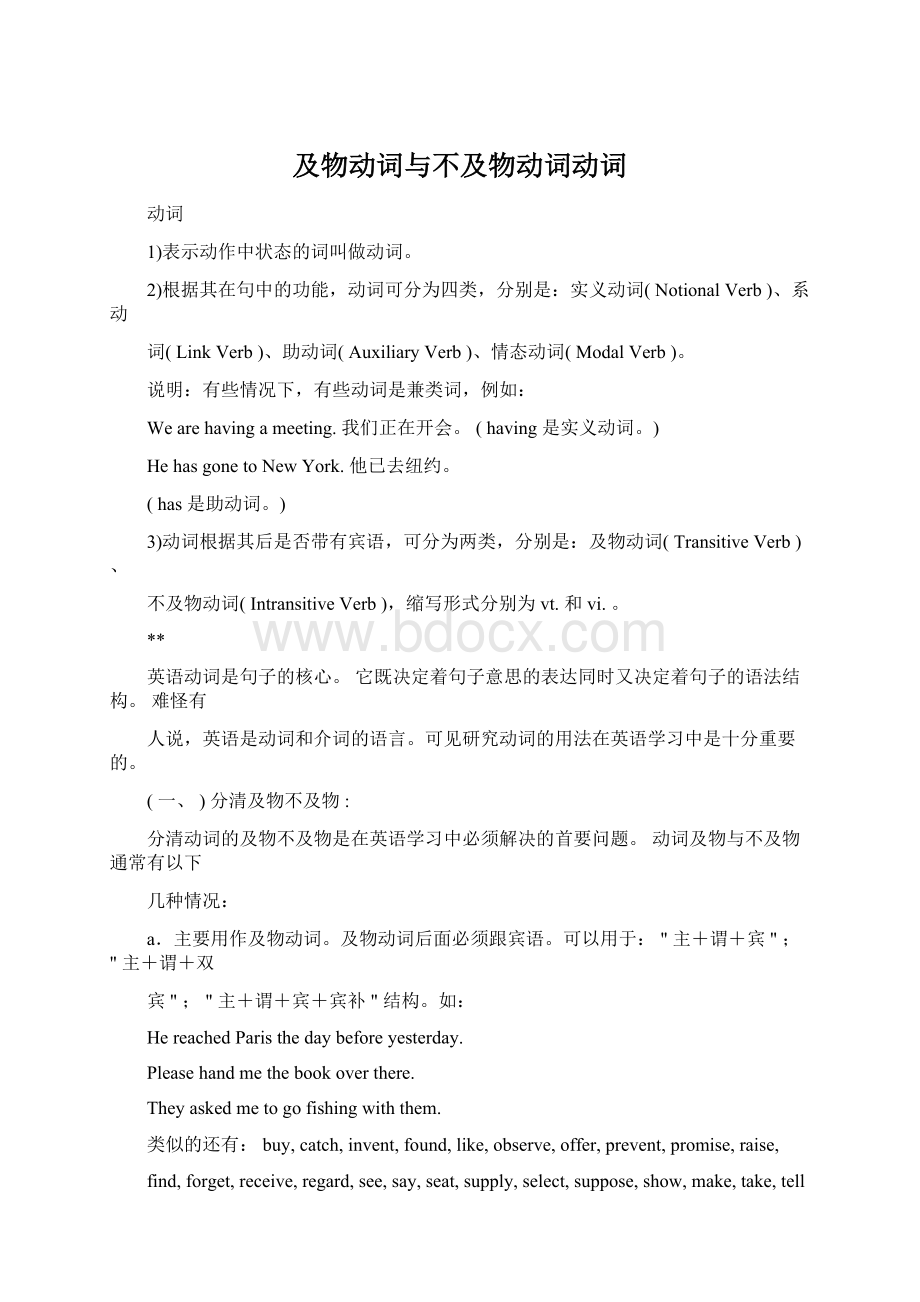及物动词与不及物动词动词Word格式.docx
《及物动词与不及物动词动词Word格式.docx》由会员分享,可在线阅读,更多相关《及物动词与不及物动词动词Word格式.docx(12页珍藏版)》请在冰豆网上搜索。

主+谓+宾+宾补"
结构。
如:
HereachedParisthedaybeforeyesterday.
Pleasehandmethebookoverthere.
Theyaskedmetogofishingwiththem.
类似的还有:
buy,catch,invent,found,like,observe,offer,prevent,promise,raise,
find,forget,receive,regard,see,say,seat,supply,select,suppose,show,make,take,tell
b.主要用作不及物的动词。
不及物动词后面不跟宾语。
只能用与:
主+谓"
ThisistheroomwhereIoncelived.
agree,go,work,listen,look,come,die,belong,fall,exist,rise,
arrive,sit,sail,hurry,fail,succeed
c.既可以用作及物又可以用作不及物的动词,其意义不变。
如begin都是作"
开始"
讲。
everybody,ourgamebegins.letusbeginourgame.类似的还有:
start,answer,sing,
close,consider,insist,read,learn,prepare,pay,hurt,improve
d.既可以用作及物又可以用作不及物的动词,其意义完全不同。
这类动词作不及物动词是一个意义;
而作及物动词时却是另一个意义。
如lift作不及物动
词时是指烟雾的"
消散"
。
wesawthemountainwhenthecloudslifted.作及物动词时是
"
升高;
举起"
Heliftedhisglassanddrank.
beatvi.跳动vt.敲、打;
growvi.生长vt.种植
playvi.玩耍vt.打(牌、球),演奏smellvi.发出(气味)vt.嗅
hangvi.悬挂vt.绞死operatevi.动手术vt.操作
(二、)辨别表动作与表结果的动词
表动作的动词强调动作的发生,不涉及该动词的结果。
Helookedatthepicture.Hesawapicture.
前一句中的动词强调"
看"
这一动作;
而后一句中的动词表示"
看到"
这一结果。
tearat;
tear,lookfor;
find,trytodosth.;
managetodosth.,preparefor;
bepreparedfor,advise;
persuade等。
(三、)记住瞬间动词
英语中不少动词所表示的动作在瞬间就可以完成.如:
Hearrivedinparisyesterday.
而另一些动词所表示的动作则可以延续.如:
Theyworkeduntil12o'
clocklastnight.
特别是在现在完成时态的句子中,瞬间动词的完成时态不能跟表示一段时间的时间状语连
用。
瞬间动词有:
arrive,borrow,buy,close,fall,finish,go,join,kill,hit,leave,
lend,die,marry,open,reach,return,start,stop,recognize等。
(四、)掌握好表状态的连系动词与表变化的连系动词
英语中的连系动词主要分为两大类:
a.表状态的连系动词。
如:
heisagoodworker.除了be而外,还有:
stand(位于),lie(位
于),stay,have,consistof,belongto,exist,weigh,own等。
b.另一类连系动词表示动作或变化,是由行为动词转化而来的。
一般在这些连系动词后跟
形容词作表语如:
hishairgrowsgrey.这类连系动词还有:
turn,become,taste,smell,
sound,look,feel,get...等。
(五、)注意词义相近,用法不同的动词
a.表主观与客观的动词
Ireceivedhisinvitationlastnight,butididn'
twanttoacceptit.
该句中,动词receive,accept都表示"
接受"
但前者表示客观地接收到什么东西;
后者表
示"
I"
的主观意愿。
类似用法的动词还有:
listento;
hear,lookat;
see,must;
have
to等。
b.表直接与间接的动词
Heheardthatthescientistwouldcometoourschool.
Heheardofthenewsthatthescientistwouldcometoourschool.
前句中hear的表示直接听说的,而后一句中hearof的表示间接听说的。
类似用法的动词
还有:
know;
knowof,speak;
speakof,talk;
talkof等。
(六、)重视多字动词的用法
所谓多字动词是指动词与某些副词、介词构成的动词词组。
一般有四种形式:
a."
动词+介词"
该结构中的动词是不及物动词,当和一些介词搭配后,则把它看成
一个整体,即把它看成一个及物动词。
Weneverthoughtofsuchsuccesswhenwefirststarted.
类似用法的还有:
agreeto,askfor,attentionto,breakinto,callupon,dealwith,
laughat,dreamof,listento,lookat,operateon,talkabout,relyon,referto...
b."
动词+副词"
该结构中的动词是及物动词的,该结构及物;
是不及物的,则不及物。
Weputoffthesportsmeet.
Afterhegrewup,hewenttolondontoworkforacompany.
类似用法的还有:
bringabout,bringup,callup,carryout,findout,giveup,hand
in,helpout,lookup,makeout,passon,pointout,putaway,putdown,putaway,
putdown,putoff,puton,ringup,setup,takeup,thinkover,turndown,useup,
workout...,wakeup,shutup,comeabout,breakout,carryon,comeup,fallover,getaway,getback,lookout,goup,goout,stayup
在这类结构中,必须注意有的多字动词即及物又可不及物。
有的甚至汉语意义也完全不相同。
Helookedupandsawhisteacherinfrontofhim.(vi.抬起头看)
Helookedupthewordinthedictionary.(vt.查找)
类似的有breakdownvi.(车等)坏了vt.分解,分为;
goovervi.走过去vt.复习,仔细查看等。
c."
动词+副词+介词"
Weshoulddoawaywiththatsortofthing.
类似的有:
giveinto,catchupwith,lookdownupon,makeupfor,putupwith
d."
动词+名词+介词"
该结构是最多,最常见的多字动词。
Wewilltakecareofthem.
catchsightof,keepaneyeon,makeuseof,makeafoolof,makefunof,
makeroomfor,makesureof,knockoutof,haveawordwith,payattentionto,put
anendto,setfireto,takeadvantageof,takeholdof,takenoteof,takenotice
of,takepartin,takepridein,takepossessionof,playatrickon,playapartin
****
同一动词有时可用作及物动词,有时可用作不及物动词。
例如:
Shecandanceandsing.
她能唱歌又能跳舞。
(sing在此用作不及物动词。
ShecansingmanyEnglishsongs.
她能唱好多首英文歌曲。
(sing用作及物动词。
4)根据是否受主语的人称和数的限制,可分两类,分别是:
限定动词(FiniteVerb)、
非限定动词(Non-finiteVerb)例如:
Shesingsverywell.
她唱得很好。
(sing受主语she的限制,故用第三人称单数形式sings。
ShewantstolearnEnglishwell.
她想学好英语。
(tolearn不受主语she的限制,没有词形变化,是非限定动词。
英语中共有三种非限定动词,分别是:
动词不定式(Infinitive)、动名词(Gerund)、
分词(Participle)。
5)根据动词的组成形式,可分为三类,分别是:
单字词(One-WordVerb)、短语动词(Phrasal
Verb)、动词短语(VerbalPhrase)例如:
TheEnglishlanguagecontainsmanyphrasalverbsandverbalphrases.
英语里有许多短语动词和动词短语。
(contains是单字动词。
Studentsshouldlearntolookupnewwordsindictionaries.
学生们学会查字典。
(lookup是短语动词。
Theyoungoughttotakecareoftheold.
年轻人应照料老人。
(takecareof是动词短语。
6)动词有五种形态,分别是:
原形(OriginalForm)、第三人称单数形式(SingularFrom
inThirdPersonal)、过去式(PastForm)、过去分词(PastParticiple)、现在分词
(PresentParticiple)。
7)及物动词不需要介词
在英语错误中,"
及物动词+介词+宾语"
(transitiveverb+preposition+object),是常
见的一种。
所谓及物动词,就是谓语动词(predicativeverb),不必通过介词引荐宾语。
相反的,不及物动词(intransitiveverb)是不带宾语的。
有许多动词,虽然性质是及物
的,但不一定要有宾语,如下列的①a和②a便是这种情形:
①a.Westudyeveryday.
b.DoyoustudyEnglisheveryday.
②a.Pleasewriteclearlynexttime.
b.Canyouwriteyourcompositionnow?
如果本质上就是不及物动词,就不会有宾语;
若要宾语,就要借介词之助,一起连用才
行,如③b和④b;
③a和④a是错的;
*③a.Thechildrenarelisteningthemusic.
b.Thechildrenarelisteningtothemusic.
*④a.Sheislaughingthecrippledman.
b.Sheislaughingatthecrippledman.
反之,及物动词不必靠介词,就可以带宾语,如上述的①b和②b,又如⑤和⑥:
5Johnisgivingabooktome.
6Whowillanswerthisquestion?
如果无意中把介词加上,就错了,如:
*⑦Whowillanswertothisquestion?
下列这句从房地产广告中看到的句子,也犯了同样的错:
Wehavemanybuyersawaitingforavailableunitshere."
Awaiting"
是个及物动词,后面的介词"
for"
是多余的,要去掉;
不然把"
awaiting"
改
为"
waitingfor"
也行。
许多人习惯上喜欢把介词加到及物动词后面,然后才带出宾语。
最常见的是
emphasize/stresson/upon"
和"
discussabout"
,如:
⑧Singaporeansseemtohaveemphasizedonmaterialgains.
Inoureducationsystem,westressuponexaminationresults.
⑩Worldleadersspentalotoftimediscussingaboutworseningeconomicproblems.
显然的,这三句里的介词"
on/upon"
about"
是多余的,不必要的。
下面是些类似的错误:
•Theyoungmustobeytotheirelders.
•Donotapproachtothatodd-lookingman.
•Theaudienceattackedontherudespeaker.
•Nothingcanescapefromhisparents'
eyes.
•Doyouhopetoserveforyournation?
•WhendidSusanmarrywithPaul?
1)及物动词后面必须跟宾语意义才完整的实义动词,叫做及物动词(transitive
verb)。
Ibelievethatthecommitteewillconsideroursuggestion.我相信委员会将会考
虑我们的建议。
“HowlongcanIkeepthebook?
”Harry哈里问:
asked.“这本书我可以借多久?
”
Dr.Bethunesetusagoodexample.白求恩大夫给我们树立了好榜样。
Crudeoilcontainsmanyusefulsubstances.原油含有许多有用的物质。
2)不及物动词本身意义完整后面不须跟宾语的实义动词,叫做不及物动词
(intransitiveverb)。
Birdsfly.鸟会飞。
IthappenedinJune1932.这件事发生于一九三;
年六月。
Mywatchstopped.我的表停了。
Shespokeatthemeetingyesterdayevening.她在昨天晚上的会上发了言。
3)兼作及物动词和不及物动词英语里有不少实义动词可以兼作及物动词和不及
物动词。
这样的动词又有两种不同的情况:
a)兼作及物动词和不及物动词时,意义不变。
试比较:
ShallIbeginatonce?
我可以立刻开始吗?
(begin作不及物动词)
Shebeganworkingasalibrarianaftersheleftschool.她毕业后当图书馆管理
员。
(began作及物动词)
WhendidtheyleaveChicago?
他们是什么时候离开芝加哥的?
(leave作及物
动词)
Theyleftlastweek.他们是上周离开的。
(left作不及物动词)
b)兼作及物动词和不及物动词时,有时意义不尽相同。
Washyourhandsbeforemeals.饭前要洗手。
Doesthisclothwashwell?
这布经得起洗吗?
4)与汉语的比较有时英语动词的及物和不及物的用法,与汉语的用法不一样,
请注意下列两种情况:
a)有的动词在英语里只能用作不及物动词,而汉语则可用作及物动词,如arrive
到达,agree同意,1isten听。
英语里这些动词后面常接介词。
Wearrivedattherailwaystationatnoon.我们于中午到达火车站。
(at不能省
去)(比较:
Wereachedtherailwaystationatnoon.)
Everybodylistenedtothelecturewithgreatinterest.每个人都很有兴趣地听讲
课。
(to不可省去)(比较:
Weallheardthelecture.)
Dotheyagreetotheplan?
他们同意这个计划吗?
(to不可省去)
b)有的动词在英语里能用作及物动词,而在汉语里则不能用作及物动词,如serve
为⋯服务。
Ourchildrenaretaughttoservethepeoplewholeheartedly.我们的儿童被教以
全心全意为人民服务[思路分析]
及物动词后面可直接接宾语,不及物动词后面不可直接接宾语,一般要加介词后
再接宾语。
实际上很多动词既是及物动词,又是不及物动词。
我举一个例子,就说write。
如Iamwriting.和Iamwritingaletter.在前一个句子
write是不及物动词,在后一个句子write是及物动词。
又如,see是及物动词,
但在特殊情况下如seeingisbelieving。
[解题过程]
从是否需要宾语来分,实义动词又有及物动词和不及物动词两类。
到达,agree同意,